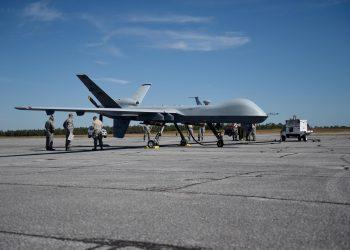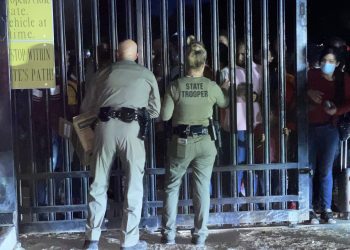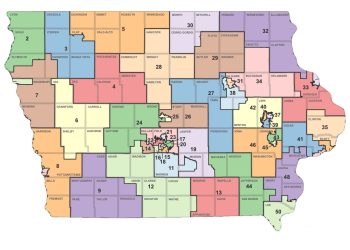DES MOINES, Iowa – On Wednesday morning, Gov. Kim Reynolds pressed for all Iowa K-12 schools to return to 100 percent in-person learning in January.
“So while we’ve learned a lot about COVID-19 since the pandemic began, one of the most encouraging facts is that the virus occurs less frequently in children than adults,” she said during a press conference at the Iowa PBS studios in Johnston.
“Here in Iowa since March, children up to the age of 10 account for just four percent of all positive cases. Three percent of cases occur among kids 11 to 14, and six percent are teens aged 15 to 18. These percentages have remained constant consistent throughout the pandemic, even since school started this fall,” Reynolds added.
She noted that the World Health Organization said that children could contract and spread the coronavirus; studies have shown that children under the age of ten are less susceptible to COVID-19 and are less likely to transmit it to others. She added that adolescents are more likely than younger children to become infected.
“When positive cases do occur in schools, it’s more likely that the virus is introduced by adult teachers and staff. Transmission within schools occurs most often between staff members, less often among staff and students, and it rarely occurs from student to student. These trends have been reported in countries across the globe, including the United States, and they’re evident right here at home,” Reynolds said.
She explained that Iowa’s public and accredited private schools were asked to provide specific COVID-19 data to the Iowa Department of Education, including their cases and mitigation efforts.
“While only a portion of the schools are reporting, what we’ve learned is that the situation in our schools, it is consistent with these findings. Since the start of the school year, among schools reporting, less than two percent of Iowa’s K-12 students have been infected with the virus. Anecdotally, most cases were due to an exposure outside of school, either because of community spread or because a household member was positive,” Reynolds said.
She pointed out that studies have also shown adverse outcomes for students when schools are closed.
“Several more studies are now emerging that suggest extended school closures, seen as a solution for virus mitigation, are actually failing students. A new study by McKinsey and Company projects that students will continue to lag academically in schools if schools remain status quo in alternate learning models through the end of the school year. The study found that students learned only 67 percent of the math and 87 percent of the reading that grade level peers would typically have learned by fall. Students, on average, could lose five to nine months of learning by the end of June 2021. Students of color could be six to 12 months behind, compared with four to eight months for white students,” Reynolds stated.
She added that if schools open in January, the predicted lag time shrinks to four or five months for white students and seven months for students of color.
The Iowa Department of Education reported last week that literacy screening scores for first graders dropped by 21 percent this fall.
“We have time to turn this around. Last spring, when schools closed, it was a precautionary measure during a time when very little was known about COVID-19,” Reynolds said. “Now we can use the knowledge that we’ve gained and the overwhelming evidence that now exist to get our students back in the classroom full time and make up for the learning that they’ve lost.”
Reynolds invited Sarah Barthole, a mother who has a third-grader and kindergartener who are enrolled in Ankeny Community Schools, to speak about her family’s online and hybrid learning experience.
She explained that this school year had been a “yo-yo year” as her children have moved from hybrid learning to full-time in-person to virtual learning and then back to hybrid learning.
“Our family would love nothing more than for them to go to school every day in-person to learn with their great teachers and be with their peers. When our boys are learning from home, we’re not always able to give them the same time and attention that their teachers give them. My husband is an essential employee for a small business. And I work in delivery management. We both need to work to support our family, just like many Iowa families do. My husband goes into the office every day. And while I’m able to work remotely, my work doesn’t stop or slow down just because my kids are at home with me. Our oldest son needs a little extra nudge to foster his reading development. While he is making great progress and strides. We knew that with the current school situation, he would need someone to give them a little extra time and attention to help keep him on track,” Barthole said.
Her family ended up hiring a tutor to work with him one on one, but Barthole acknowledged many families could not afford to do that.
“Even more apparent, elementary school-age children are too young to be expected to do self-guided instruction on asynchronous days, not because they aren’t capable technically, but because the development of their mind and capacity to learn requires instruction. They need teacher interventions and engagement every day,” Barthole added.
She advocated for full-time school since she learned Ankeny Community Schools planned to start the year using a hybrid model. She said parents must have a voice when it comes to decisions like these.
“As parents, we deserve a choice on the learning model we feel is best for our children. Parents have been able to select a full time, 100 percent virtual option, which is great, annd I’m glad we have it for those parents that want that experience. And parents like me want a choice to be able to send my kids to school full time 100 percent in person as well. It’s a perfectly reasonable expectation that our school district would offer its families this option,” Barthole said.
Reynolds said the legislature needs to take up this issue in the upcoming session. Currently, state law allows schools to pursue a hybrid model, but 50 percent of student learning must occur in-person. The Iowa Department of Education can issue waivers based on the school district’s county’s positivity rate and school attendance.
The governor said it’s time for schools to go back to in-person learning.
“I think parents need to have the option to be in school. I think we need to do everything we can right now to get our kids back in the classroom. And I believe that the data supports that. I believe, eventually, we’re going to potentially be doing more harm than we are by keeping them out of school,” Reynolds stated.
She did add that most of Iowa’s school districts have students back in the classroom five days a week using layered mitigation efforts. Currently, according to the Iowa Department of Education, 24 school districts and two accredited non-public schools are providing primarily continuous/remote learning.
“They’re doing everything they can to make sure that those kids are there in a safe and responsible way. And I believe that’s what we need to do as Iowans. I believe we can do it. Our parents are asking for it,” Reynolds stated.
Listen to the full press conference below:















